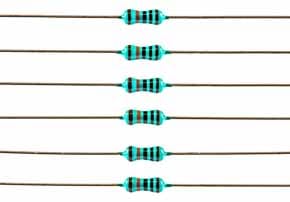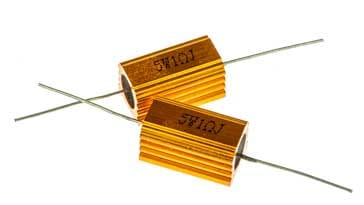Where & How to Buy Resistors: at the right price, type & quality
Buying resistors may not always be as straightforward as it may seem at first sight - here are some ideas on getting the right product, at the right price, from the right place.
Home » Electronic components » this page
Resistor Tutorial Includes:
Resistors overview
Carbon composition
Carbon film
Metal oxide film
Metal film
Wirewound
SMD resistor
MELF resistor
Variable resistors
Light dependent resistor
Thermistor
Varistor
Resistor colour codes
SMD resistor markings & codes
Resistor specifications
Resistor maximum voltage
Where & how to buy resistors
Standard resistor values & E series
Resistors are needed in virtually every electronic circuit, whether in assemblies for mass production or for a one off for development of for the maker / hobbyist.
Resistors can determine many of the properties for the circuit, and also they are used in large quantities - electronics manufacturing uses huge quantities, both as leaded electronic components and surface mount devices.
Whatever the reason for their need, it is important to buy the right resistors and also for a good price. Also the source of supply or electronic components distributor can be important in some applications.
Accordingly, knowing where to buy resistors and also how best to buy them can present a challenge.
As with any decision, when buying resistors there are several issues to balance: cost, which electronics components distributor, quality, original manufacturer, and much more.

Choosing the correct resistor to buy
One of the crucial element of buying resistors is to choose the correct resistor. There are several types of resistor, each with their own advantages and disadvantages:
Carbon composition: These resistors are seldom used these days. They find two main uses: the first is for the restoration and repair of vintage radios where they were initially used: secondly carbon composition resistors are ideal for circuits where they need to absorb high transients.
As carbon composition resistors have a relatively large bulk, they can absorb high transients for short periods and they are used in applications where these transients need to be accommodated. As a result it is still possible to buy these electronic components. However, for normal use these resistors are bulky, they have a tendency to vary in value and they generate considerable amounts of noise.
- Carbon film: Carbon film resistors were the next resistor development. They were much smaller and more stable. Although the noise level was not as high as that of carbon composition resistors, it was still higher than that of more modern resistors like the metal film resistor. It is still possible to buy carbon film resistors from most stockists and distributors.
- Metal oxide film : Metal oxide film resistors axial leaded resistors are made from a thin film of metal oxide that has been deposited into a ceramic rod. The resistor was considered as the successor to the carbon film resistor as its performance was superior but as the metal film resistor was introduced, with a superior level of performance to that of the metal oxide film resistor, its use declined.
Metal film: Metal film resistors are the standard leaded format that is used these days. A variety of values and wattages are available. They are low noise and can be obtained to 1% or 2% as standard. Closer tolerance varieties are available.
They are widely available as leaded components, and the same technology is used in surface mount devices as well.
- Surface mount resistors: Surface mount resistors are used in vast quantities for volume manufacture. As mentioned above, metal film resistor technology is generally used as it lends itself to high volume manufacture of surface mount resistors.
Diagram of a typical SMD resistor Wire wound resistors : Wire wound resistors are typically used where higher power limits are required. Types are available that can be bolted to a chassis or heat sink to remove the heat. Sometimes they may also be used for very close tolerance applications in measuring instruments as they can be very closely trimmed to provide the required resistance, and they are also very stable.

"Aluminium cased wire wound resistor suitable for bolting to a heatsink
Resistor specifications & parameters
When buying resistors it is necessary to closely specify the required resistor. These may seem obvious but there may be a few hints and tips that can help get the most appropriate resistor - some specs to watch out for.
Resistance value: The resistance is the obvious specification for any resistor whether leaded or a surface mount device.
Although the value will be determined by the electronic circuit design, it should be remembered that sticking tot he E series of standard values helps reduce the cost. Also reducing the number of different values in any design will reduce the manufacturing costs as they will be fewer different types of component to handles for any manufacturing stage. The ideal is to use E3 series resistors where possible, using E6 series next if needed and then E12 etc, but wherever possible using resistors from the lowest E series possible.
- Tolerance: Most resistors these days are manufactured to a high tolerance. Most components used for electronic circuits will have a tolerance of 1 or 2%. However beware of older types which may have a much wider tolerance on them.
Power handling: Care needs to be taken when specifying the power handling. As current is passed through the resistor, heat is obviously dissipated and the temperature rises. They can run quite hot in some applications. As the temperature rises, so they can become less reliable in the long term, or even burn out in the short term.
When choosing a resistor to buy for a given application calculate the power dissipation and run it well within its ratings. Many companies that design electronic equipment recommend running them at a maximum of 50 or 60% of their maximum rating. This gives a good margin and ensures the long term reliability is maintained.
Stray inductance: For some RF applications it is necessary t think of the RF performance of the resistors. Surface mount resistors are good into the microwave region as the fact that they do not have leads and they are small means they have very low levels of inductance.
Metal film leaded resistors are OK up to VHF and UHF, but wirewound ones are normally to be avoided above 100kHz or so. There are some specially wound forms of wirewound resistor that have lower levels of inductance, but normally this type should be avoided for RF.
- Surge handling : In some applications it may be necessary for resistors to be able to handle short transient voltage spikes. The old carbon composition resistors are still used for this as they have a large thermal mass and can tolerate the spikes, even if other elements of their performance are not what might be expected these days.
- Maximum working voltage: One element of a resistor specification that may be important when buying resistors for some applications is the maximum working voltage. Today, many resistors only operate at low voltage and therefore this is not an issue, but for others it may be. For higher voltage applications, check on the datasheets whether the voltage expected is within the limits for the resistor. It is wise to have a good margin for this.
These are a few simple guidelines to help when choosing which resistors to select for an electronic circuit design and how to buy them.
Electronic components distributor / supplier choice
The selection of the right electronic components distributor is very important when buying resistors for some applications. For many maker, hobbyist and students, cost and short delivery are two of the key issues and almost any supplier will be acceptable. For other commercial organisations there may be other issues to consider and the choice of electronic component distributor is more crucial.
Timescales: It is often necessary to consider the timescales when selecting who to buy resistors from. Some electronic component distributors may be able to deliver very quickly or on a required date. and this is an advantage in many instances. Having the right product when it is required can mean that the amount of inventory held on the electronics manufacturing site can be reduced.
Also having the electronic components reliably scheduled to arrive when they are needed can reduce the difficulties of handling shortages in the manufacturing process.
- Cost: Cost is a major consideration when buying resistors. Particularly for private individuals this may be one of the most important considerations. Normally quality is good, but this needs to be taken into account especially when prices are low. Normally though quality is very good.
- Wide availability: In some instances a wide availability of stock is needed and this may be a reason for selecting a particular electronic components distributor or stockist.
- Traceable stock: For many professional applications it is necessary to have electronic components, and in this case resistors that are from a guaranteed source and not counterfeit. If counterfeit stock entered the supply chain then it could have an impact on performance, reliability and a number of other factors. In addition to this, there can be penalties of stock is shown to be counterfeit, particularly when manufacturing equipment for government organisations. Using an established, authorised electronic components distributor can ensure that the stock is reliable.
- Ship to stock: For large scale electronics manufacturing, it is possible to set up a facility known as ship to stock. By entering relationship with an electronic components distributor, they can be aware of the requirements and when stock runs low at the production facility, then new components can be shipped directly into the production line within minimum of formality.
Purchasing components even like resistors can involve a number of decisions. For small quantities like those used for home construction, resistors can be bought from a host of places, but for large scale electronics manufacturing, the choice can be a little more involved, but by selecting the right supplier many savings can be made in terms of the ease of supply as well s the component cost and performance.
 Written by Ian Poole .
Written by Ian Poole .
Experienced electronics engineer and author.
More Electronic Components:
Batteries
Capacitors
Connectors
ADC
DAC
Diodes
FET
Inductors
Memory types
Phototransistor
Quartz crystals
Relays
Resistors
RF connectors
Switches
Surface mount technology
Thyristor
Transformers
Transistor
Unijunction
Valves / Tubes
Return to Components menu . . .





